Download Master Chef H405 Specifications
Transcript
SERIAL#: H405 Propane Barbecue S A F E U S E , C A R E A N D A S S E M B LY M A N U A L DANGER If you smell Gas 1. Shut off gas to the appliance. 2. Extinguish any open flame. 3. Open lid. 4. If odor continues, keep away from the appliance and immediately call your gas supplier or your fire department. WA R N I N G 1. Do not store or use gasoline or other flammable vapours and liquids in the vicinity of this or any other appliance. 2. An LP cylinder not connected for use shall not be stored in the vicinity of this or any other appliance. WA R N I N G Failure to follow all of the Manufacturer’s instructions could result in hazardous fires, explosions, property damage, or serious personal injury or even death. ONE YEAR LIMITED WA R R A N T Y 85-1631 G43702 WA R N I N G Follow all leak check procedures carefully prior to operation of barbecue, even if grill was dealer assembled. Do not try to light this barbecue without reading the Lighting Instructions section of this manual. Read and save this manual for future reference. If pre-assembled, leave this manual with unit for consumer’s future reference. For product inquires, parts, and warranty and troubleshooting support, please call 1-877-707-5463. THIS BARBECUE IS FOR O U T D O O R U S E O N LY WA R R A N T Y ONE Year Limited Warranty This Masterchef® Barbecue carries a 1 year limited warranty against defects in manufacturing workmanship. This Limited Warranty is nontransferable and becomes void if used for commercial or rental purposes. This warranty applies only when grill is used in Canada. The bill of sale or a copy will be required together with the serial number and model number when making any warranty claims from Trileaf Distribution. Trileaf Distribution reserves the right to have its representatives inspect any product or part prior to honoring any warranty claim. Trileaf Distribution shall not be liable for any transportation charges, shipping & handling charges or labor cost. This warranty is for replacement of defective parts only. The Manufacturer will not be responsible for incidental or consequential damages or any labor cost. Inability to provide proof of purchase, or if warranty coverage has expired, any request for parts will be subject to parts, shipping and handling fees. This limited warranty does not cover damage due to chipping and scratching of porcelain or painted surfaces including Cooking grates, nor does it cover corrosion or discoloration due to misuse, lack of maintenance, grease fires, hostile environments, accidents, alterations, abuse or neglect, improper installation and failure to read and/or abide by any product warnings. This limited warranty does not cover any damage sustained during removal or storage of this BBQ. Part failure due to lack of cleaning and maintenance, or use of improper cleaning products such as Oven Cleaner will not be covered under this manufacturers warranty. This limited warranty does not cover any scratches or dents, corrosion or discoloring caused by heat, abrasive or chemical cleaners. Parts installed from other manufactures will nullify this warranty. ONE Year Limited Warranty For one year from the date of original retail purchase Trileaf Distributions will replace any grill part that fails or is found to be defective to the degree of nonperformance under normal household use, during the limited warranty period. Trileaf Distributions ltd. are not responsible for any grill damage sustained during moving, storage, assembling or cleaning. Unless otherwise noted, as in above limitations, all components are covered for a period of one year. Important: Should you have difficulty operating this product, or have a part that has become defective within the stated warranty period, DO NOT RETURN TO STORE. STORES DO NOT STOCK REPLACMENT PARTS AND ARE UNABLE TO HELP WITH TROUBLESHOOTING ADVICE. PLEASE CALL 1-877-707-5463. Have your Proff of purchase, serial number and model number available so that the customer support agent can be of assistance. Purchaser: By accepting delivery of this Barbecue the purchaser, hereby accepts the foregoing and expressly waives any other remedy and damages, direct, indirect, and consequential. INFORMATION INSTALLATION ADDITIONAL WA R N I N G S The installation of this appliance must be in accordance with all local codes, or in the absence of local codes: • Canadian installation must conform to the current national standards, which at this time are CAN/CGA-B149.1/2-Natural Gas/Propane installation code. a) Do not store a spare LP-gas cylinder under or near this appliance; b) Never fill the cylinder beyond 80 percent full; and c) If the information in “(a)” and “(b)” is not followed exactly, a fire causing death or serious injury may occur. Minimum clearance to adjacent combustible materials: • 76 cm (30˝) from furthest protruding edge on side of barbecue. • 76 cm (30˝) from furthest protruding edge on back of barbecue. See Drawing A Always keep the area around this barbecue clean and clear of any and all combustible materials such as gasoline or other inflammable liquids, paper or oily rags. • Do not operate this barbecue under any overhanging or unprotected construction. • Remember this barbecue is for outdoor use only and is not for use on any boat or recreational vehicle. • Use this barbecue outdoors in a well-ventilated area and we recommend at least 3 m (10’) from any dwelling or other buildings. • Do not use in garages, or any other enclosed area. • Do not leave your barbecue unattended while in operation. • Do not obstruct the flow of combustion and ventilation air to the barbecue. • Do not use while under the influence of drugs or alcohol. • Do not store any spare L.P. (propane) cylinder, full or empty, under or near your barbecue. • Do not allow children to play anywhere near the barbecue. • Minimum clearance of 76 cm (30”) on both sides and back of the barbeque. Drawing A USE OF L . P. G A S C Y L I N D E R Self-contained The self-contained (propane) gas system is designed to be used with only a 9.1 kg (20 lb) propane cylinder equipped with a type-1 cylinder valve and incorporating an overfill protection device (O.P.D.). This barbecue cannot be connected to an existing #510 P.O.L. type valve cylinder (which has left-handed threads). Propane Gas System DO NOT connect to a propane cylinder exceeding 9.1 kg capacity or use a cylinder with any other type of cylinder valve connection device. The type-1 valve can easily be recognized by the large external thread on the outside of the valve. Older existing valves do not have this outer external thread. Any attempt to connect a regulator to any connector other than the mating type-1 connector could result in fires, injuries or property damage, and could take out the important safety features built into the type-1 system. Also connecting the #510 P.O.L. fitting to the cylinder will negate the flow control and the temperature shut-off features built into the new type-1 connection system. • The cylinder should not exceed 472 mm (18 1/2˝) in height and 317 mm (12 1/2˝) in diameter. LP-gas supply cylinder to be used must be constructed and marked in accordance with the specifications for LP-gas cylinders of the U.S. Department of Transportation (DOT) or the National Standard of Canada, CAN/CSA-B339, Cylinders Spheres and Tubes for the Transportation of Dangerous Goods. 1 DANGER • NEVER store a spare LP tank under or near grill or in enclosed areas. Never fill the cylinder beyond 80% full. • An overfilled or improperly stored tank is a hazard due to possible gas release from the safety relief valve. • If you see, smell or hear escaping gas, immediately get away from the LP tank/grill and call your fire department. • If the above is not followed exactly, a fire causing death or serious injury may occur. • The Cylinder must also be equipped with: • A shut-off valve with a correct cylinder valve outlet as specified in current standards. • Canada: CAN/ CGA 1.6g-M97 Outdoor Gas Grills. • U.S.A: ANSI Z21.58a-2006/CSA 1.6a-2006 Outdoor Cooking Appliances. a) Constructed and marked in accordance with the Specifications for LP-Gas Cylinders of the U.S. Department of Transportation (D.O.T.) or the National Standard of Canada, CAN/CSA-B339, Cylinders, Spheres and Tubes for Transportation of Dangerous Goods; and Commission, as applicable; and b) Cylinder connection device compatible with the connection for outdoor cooking appliances. c) A listed Overfilling Protection Device (O.P.D.). d) A safety relief valve with direct connection to the vapour space of the cylinder. e) A collar to protect the tank shut-off valve. f ) A device for vapour withdrawal. g) A ring on the bottom to secure the tank to its support assembly. Warning Always turn off the cylinder valve completely when the barbecue is not in use. Always handle the tank valve with utmost care. • Never connect an unregulated L.P. gas cylinder to the barbecue. • Always keep the cylinder, in use, securely fastened in an upright position. • Never store a spare cylinder, empty or full, near or under the barbecue when in operation. • Never expose the cylinders to direct sunlight or excessive heat. • Never insert any kind of objects into the valve outlet as this may damage the backcheck; a backcheck that is damaged can leak, and a leaking propane cylinder can result in fires or explosions, property damage, severe injuries or death. • • To Connect Regulator Carefully insert brass nipple of regulator connection into tank outlet. Screw black plastic nut clockwise onto tank valve outlet until it comes to a stop. Hand-tighten only. Do not use tools of any kind. TRANSPORTATION AND STORAGE O F L . P. C Y L I N D E R The propane cylinder is totally safe when handled properly, but if misused, the result could be an explosion or fire resulting in serious personal injury and/or property damage. Warnings Always recap the cylinder with cap provided when not connected to the barbecue. • Do not store the cylinder in any enclosed area such as a garage, and make sure the storage area has lots of ventilation. • Do not store the cylinder near any appliances, or in any areas that may become hot such as the trunk of a vehicle. • Make sure the cylinder is out of the reach of children. • When transporting or storing the cylinder, make sure it is in an upright position and not on its side. • Do not smoke around the cylinder, especially when transporting it in a vehicle. • 2 FILLING THE L . P. C Y L I N D E R For safety reasons the LP gas cylinder, if supplied with your barbecue, has been shipped empty. The cylinder must be filled prior to use and must have the air purged. For safety, follow these instructions when having your cylinder filled: • Have only your local qualified LP gas dealer fill or repair a cylinder. • Do not overfill the cylinder beyond the safe 80% fill level. • Make sure the dealer tests and checks the cylinder for leaks after filling. WA R N I N G If the above instructions are not completely adhered to, it could cause a fire /explosion, resulting in death or serious Injury, or property damage. SAFETY HOSE AND REGULATOR Propane Models: Your barbecue is designed to operate on L.P. propane gas at a pressure of 2.74 Kpa (11˝ water column). A regulator preset to this pressure is supplied with the barbecue and must be used. This regulator is equipped with the type-1 quick-closing connecting system, which incorporates these safety features: • Will not allow gas to flow until a positive seal has been made. • Has a thermal component that will automatically shut off the flow of gas between 115–150ºC (240–300ºF). • Has a flow limiting feature, which will restrict the flow of gas to 10 cubic feet/hour. Warning Should the large, black thermal-sensitive coupling nut be exposed to any extreme temperatures above 115ºC it will soften and allow the regulator probe to disengage from the valve, and will shut off the gas. Should this occur, do not try to reconnect the nut; instead replace the whole regulator assembly with a new one (see the attached parts listing for details). The regulator probe also contains a flowsensitive feature, which limits the flow of gas to 10 cubic feet/hour, in the event of a regulator malfunction or hose leak. If the flow control feature is activated, the cause of this excessive gas flow should be investigated and corrected before using the barbecue again. 3 Attention: Improperly lighting the barbecue can activate the flow control feature, resulting in lower heat output. If this occurs, the re-flow feature must be reset by turning off all the burner controls and the cylinder valve. Wait at least 30 seconds before slowly turning on the cylinder valve, and then after another 5 seconds turn the burner valve on and light the barbecue. Never connect this barbecue to an unregulated propane gas supply, or to another kind of gas. Do not alter or change the hose or regulator in any way. • Visually inspect the whole hose assembly before each use for evidence of wear or damage such as cracks, burns, or even cuts. If any damage is found, replace the assembly before using the barbecue. Use only the recommended replacement hose. • To avoid possible damage to the hose, do not allow any grease or other hot materials to fall on the hose, and make sure the hose does not contact any hot surfaces of the barbecue. • The connection fitting must be protected when it’s disconnected from the cylinder. Do not allow the fitting to bump or drag on the ground as nicks and scratches could help create a leak when connecting back to the cylinder. • It is important to do the “Leak Test” procedure every time a cylinder is refilled, or any of the components are changed, and especially at the beginning of a new season. • SAFETY LEAK TESTING Attention: A leak test ensures that there are no gas leaks prior to lighting your barbeque. Perform A “Leak Test” Before lighting your barbecue for the first time. Every time the cylinder is refilled, or any component is replaced. • At least once every year, preferably at the start of the season. • When having difficulty lighting burners, or experiencing irregular burn patterns. • • The “Leak Test” must be done outdoors, away from heat, open flames and flammable liquids. Do not smoke while performing the test. Use only a mixture of 50/50 liquid soap and water for leak testing. Never use a match or open flame. The Following Must Be Checked The tank valve including the threads into the tank (drawing C). All tank welds (drawing B). • Regulator fittings and tank connections (drawing C). • All hose connections (drawing D), plus side burner hoses if so equipped (drawing E). • With a newly filled and tested propane tank attached to the barbecue and all the controls turned OFF, slowly open the cylinder valve one full turn. • Brush Soap solution on all connections and components listed above and shown in the drawings B, C, D and E. • Look carefully for bubbles forming, which is an indication of leaking gas. • Tighten the connections at the bubbled areas until re-testing shows no indication of any leaks (shut off cylinder while correcting any leaks). • Shut off the cylinder valve and ensure all control valves are off. • Do not use the barbecue if any leaks cannot be stopped. Turn off the gas cylinder valve, remove the gas cylinder and seek assistance from a qualified gas appliance service mechanic or gas dealer. • • Drawing B Drawing D Drawing C Drawing E (if equipped with a side burner) 4 PRIOR TO USING Do not use your barbecue until you have carefully read and fully understand all the information in this manual. Please ensure the following: • Your barbecue is properly assembled. • There are no leaks in the system (see “Leak Test”). • The burner is properly assembled, with the venturi tubes seated over the valve outlets (drawing F) and that there is nothing blocking the venturi tubes (drawing G). • Ensure that all power cords and/ or gas supply hoses will not touch or be near the surfaces that will get hot. • The barbecue is in a safe location (see installation). Insert valve outlets into Venturi tubes approximately 6mm (1/4”) Drawing F WA R N I N G During shipment or storage, it’s possible that small insects like spiders could find their way into the venturi tubes and nest or make webs. This could block the flow of gas through the venturi tube causing a smoky yellowish flame, or prevent a burner from lighting. It could even cause the gas to burn outside the Venturi tube, which could seriously damage your grill. If these occurs, turn off the gas flow and wait for the barbecue to cool down. When the barbecue has cooled, remove the burner and clean out the venturi tubes with a brush or pipe cleaner. Replace the burner and ensure that the venturi tubes are seated over the Igniter Electrode located on the gas valves. Cleaning the venturi tubes should be conducted periodically, especially at the start of the season. Natural Hazards Insects and Spiders Note: Damage resulting from blocked venturi tubes is not covered under the warranty. Drawing G CAUTION If you notice that your grill is getting hard to light or that the flame is not as strong as it should be, take the time to check and clean the venturis. SPIDER ALERT Control Panel Gas Collector Box & Ignitor Burner Spider Webs inside Venturi Valve Ensure that the valve outlets (igniter electrode) are assembled into the venturi tubes approximately 6 mm (1/4˝) and that the valve outlets and venturi tubes are approximately parallel to the bottom of the lower body. Air Shutter Venturi In some areas of the country, spiders or small insects have been known to create “flashback” problems. The spiders spin webs, build nests and lay eggs in the grill is Venturi tube(s) obstructing the flow of gas to the burner. The backed-up gas can ignite in the Venturi behind the control panel. This is known as a flashback and it can damage your grill and even cause injury. To prevent flashbacks and ensure good performance the burner and Venturi assembly should be removed from the grill and cleaned before use whenever the grill has been idle for an extended period. Lift Out Burner Assembly Remove Burner Clips Spider Webs Clean Out Venturi Inside Venturi 5 LIGHTING THE BARBECUE Prior to lighting your barbeque, visually check all hoses before each use, for nicks, cracking, abrasions or cuts. If the hose is found to be damaged in any way, do not use your barbeque. A replacement hose and regulator is required. • Make sure you have followed all the checks, procedures and instructions in all previous sections before attempting to light the barbecue. Important Always raise the barbeque lid before lighting the burner. Do not lean over the barbeque when lighting in case of back flash. • Making sure the main barbecue control knobs are off, slowly and carefully open the propane gas cylinder valve. • Visually check the flames every time you light your barbeque. If the flame is abnormally small or smokey yellow – shut off the barbeque and check the venturi tubes for blockage or refer to the Troubleshooting Guide. • • Using The Igniter To Light The Burner Ensure burner control knobs in the off position before opening gas supply. 1. Open the lid before lighting. 2. Open the gas supply valve and wait 5 seconds. 3. Push in and turn a single main burner control knob to ‘HIGH’. 4. Depress the igniter until a click noise is heard. 5. If the burner does not light immediately (within four seconds), turn burner control knob off and wait 5 minutes to clear the gas. 6. Repeat steps 1 to 5. If burner still fails to light, refer to the Troubleshooting Guide to determine the cause and solution, or try the Match Lighting procedure below. CAUTION If ignition does NOT occur in 5 seconds, turn the burner controls OFF, wait 5 minutes and repeat the lighting procedure. If the burner does not ignite with the valve open, gas will continue to flow out of the burner and could accidently ignite with risk of injury. 6 Match-Lighting Do not lean over grill while lighting. 1. Open lid. Turn on gas at LP cylinder. 2. Push in burner knob to HI. Be sure burner lights and stays lit. 3. Place lit match into match holder, then into lighting hole on left side of grill. Match Lighting Procedure Lighting the other side of the dual burner: Once one side of the dual burner has been lit, push in and turn the other control knob to ‘HIGH’. The unlit burner will light automatically. WA R N I N G If the heat output is too low, the flow control feature may have been activated by a gas leak or improper lighting procedure. If so, turn off the burner valve and cylinder valve, and perform the “Leak Test”. If there aren’t any leaks, re-light the burner. WA R N I N G Use this slot for manual match lighting Never stand with your head directly over the Barbecue when preparing to light the main burners, to prevent possible bodily injury. WA R N I N G IF THE SELECTED BURNER DOES NOT LIGHT, immediately turn the burner control knob and cylinder valve to the OFF position, to prevent gas buildup. Wait five minutes for the gas to clear and then repeat the preceding starting procedure. If the burner will not light when using the ignitor, follow the match lighting instructions. Shutting Down The Barbecue After Use Turn off the gas cylinder valve. • Turn the burner control valve to the “Off ” position. • This sequence is important as it prevents residual gas from being left in the system under pressure and will make the next use easier. 7 CLEANING Cleaning the Burner Assembly AND MAINTENANCE Follow these instructions to clean and/or replace parts of burner assembly or if you have trouble igniting grill. 1. Turn gas off at control knobs and LP cylinder. 2. Remove cooking grate and flame tamer 3. Under grill remove grease cup, disconnect ignitor wire from burner. 4. Inside grill remove burner assembly (A), clean ceramic portion of electrode with rubbing alcohol and a swab. 5. Clean outside of burner with soap and water. Lay burner upside down on flat surface, insert garden hose to force water through tubes. Make sure water comes out of all burner holes. Open clogged holes with a thin wire. Shake out excess water and examine holes. Due to normal wear and corrosion some holes may become enlarged. If any large cracks or holes are found replace burner. 6. If grill is to be stored, coat burner lightly with cooking oil. Wrap in protective cover to keep insects out. 7. If not storing grill after cleaning, replace burner into grill bottom. Correct burner-to-valve engagement Very Important: Burner tubes must re-engage valve openings. See illustration (A). 8. Reattach ignitor wire to electrode. 9. Reposition flame tamer and cooking grate. Reattach clean grease cup to grease hook. 10. Before cooking again on grill, perform a “Leak Test” and “Burner Flame Check”. Burner Tube Valve Storing Your Grill Clean cooking grates. Store in dry location. • When LP tank is connected to grill, store outdoors in well ventilated space and out of reach of children. • Cover grill if stored outdoors. • Store grill indoors ONLY if LP tank is turned off and disconnected, removed from grill and stored outdoors. • When removing grill from storage follow "Cleaning Burner Assembly" instructions before starting grill. • • 8 Food Safety Food safety is a very important part of enjoying the outdoor cooking experience. To keep food safe from harmful bacteria, follow these four basic steps: Clean: Wash hands, utensils, and surfaces with hot soapy water before and after handling raw meat and poultry. Separate: Separate raw meats and poultry from ready-to-eat foods to avoid cross contamination. Use a clean platter and utensils when removing cooked foods. Cook: Cook meat and poultry thoroughly to kill bacteria. Use a thermometer to ensure proper internal food temperatures. Chill: Refrigerate prepared foods and leftovers promptly. How To Tell If Meat Is Grilled Thoroughly Meat and poultry cooked on a grill often browns very fast on the outside. Use a meat thermometer to be sure food has reached a safe internal temperature, and cut into food to check for visual signs of doneness. • Whole poultry should reach 180° F; breasts, 170° F. Juices should run clear and flesh should not be pink. • Hamburgers made of any ground meat or poultry should reach 160° F, and be brown in the middle with no pink juices. Beef, veal and lamb steaks, roasts and chops can be cooked to 145° F. All cuts of pork should reach 160° F. • NEVER partially grill meat or poultry and finish cooking later. Cook food completely to destroy harmful bacteria. • When reheating takeout foods or fully cooked meats like hot dogs, grill to 165° F, or until steaming hot. • WA R N I N G Do Not leave your barbecue unattended, and watch out for children around the barbecue. Make sure the barbecue is functioning safely at all times. DO NOT move the barbecue while cooking. 9 TROUBLESHOOTING GUIDE Problem Burner will not light (match or igniter) Possible Causes Corrective Action • Blocked venturi tubes • Clean out blockage • Cylinder or gas supply valve turned off • Open cylinder or gas supply valve • Venturi tubes not properly sealed over valve igniter electrodes • Ensure proper venturi tube assembly • Burner ports blocked • Clean/replace burner • Low or out of propane • Refill cylinder • Flow control device activated • Follow correct lighting procedure, and perform leak test • Regulator not fully tightened into cylinder • • Tighten regulator fully (hand tighten) onto cylinder Straighten fuel hose Burners not hot enough Flames smoky yellow Burner lights with match but not with igniter Flame blows out/down through base Too much heat/excessive flare-up • Partially blocked venturi tubes • Clean out blockage • Excess cooking salts on burner • Clean burner • Air shutter closed (side and rear rotisserie burner only) • Open air shutter • Loose wire connection • Make sure all connections are tight • Broken electrode ceramic Poor ground • • Ensure collector box, burner and igniter are assembled properly • Faulty igniter • Replace igniter • High wind conditions • Relocate barbecue back towards wind • Propane low • Refill cylinder • Excessive fat in meat • Trim meat, turn down burner controls and/or fuel supply • Grease drain plugged • • Clean casting base and burner Clean heat plate • Cooking system not positioned correctly • Position cooking system correctly Flames under heat control console • Blocked venturi tubes • Immediately shut off gas at source, allow grill to cool and clean out venturi tubes Regulator humming • This is not a defect or a hazard • Temporary condition caused by high outside temperatures and a full propane cylinder Incomplete flame • Plugged, rusted or leaking burner • Clean/replace burner For product inquires, parts, and warranty and troubleshooting support, please call 1-877-707-5463. 10 11 PARTS LIST 85-1631 12 (G43702) Item No. Quantity Description Part No. AA 1 Top Lid G437-0026-01 AB 1 Handle Top Lid G306-0002-01 AC 1 Thermometer G305-0039-01 AD 2 Upper hinge G436-0042-01 BA 1 Burner Box Assembly G437-1301-01 BB 2 Cooking Grate G437-0003-01 BC 1 Flame tamer G434-0005-01 BD 1 Burner G437-1400-01 BE 1 Warming Rack G434-0003-01 BF 1 Burner Box Heat Sheild G437-0023-01 BG 2 Lower hinge G210-0019-01 CA 1 Control Panel G437-0027-01 CB 2 Control Knob G401-0023-01 CC 1 Igniter includes electrode wire G206-0701-01 CD 1 Valve Assembly G436-0005-01 CE 1 Regulator G602-0050-01 DA 1 Right Cart Leg G437-0800-01 DB 1 Left Cart Leg G437-0700-01 DC 1 Upper, Front Panel G437-0030-01 DD 1 Lower, Front Panel G437-0032-01 DE 1 Upper Back Brace G437-0011-01 DF 1 Lower Back Brace G437-0012-01 DG 1 Tank exclusion, wire frame G437-0017-01 DH 1 Front End cap G437-0028-01 DI 1 Back end cap G437-0029-01 DJ 2 Wheel G401-0058-01 DK 1 Wheel Axle G437-0007-01 DL 1 Tank heat shield G210-0012-01 DM 1 Lower heat shield G437-0031-01 DN 1 Tank retension bracket G206-0028-02 DO 1 Grease cup hook G401-0067-01 DP 1 Grease cup G401-0066-01 DQ 1 Condiment basket G434-0012-01 EA 1 Right side shelf G437-0300-01 EB 1 Left side shelf G210-0300-01 EC 1 tool hooks G305-0027-01 ED 1 Hardware pack G43702-B001-01 EF 1 User manual G437-003-020801 EG 1 Match Holder G401-0079-02 Manual Hardware Pack EF ED 13 A S S E M B LY I N S T R U C T I O N S Hardware Pack List Key No. Tools needed for assembly are shown below. Before assembling the barbecue, please ensure that you have all the hardware needed. Before assembling the barbecue, read these instructions carefully. Assemble the barbecue on a flat, clean surface. Note: Do not fully tighten all the nuts during initial stage. Grill is heavy. You should have two people assemble the barbecue together. Description Part Number 1 NO.10x13 Machine Screw 20124-10013-036 35 2 NO.10X30 Machine Screw 20124-10030-036 6 3 NO.10 Flange Nut 31224-10000-036 39 4 Hinge Pin G306-0005-9088 3 5 Large Fiber Washer G305-0024-9088 1 6 No. 10 Wing Nut 33300-10000-036 2 7 Fiber Washer G501-0044-9000 4 8 Lid Handle Fiber Washer G308-0027-9031 2 9 Bolt G306-0004-01 2 Please refer to the part numbers underneath the hardware name for use when ordering parts under warranty. Key #1: NO.10x13 Machine Screw (x35) Key #2: NO.10X30 Machine Screw (x6) Key #3: NO.10 Flange Nut (x39) Key #4: Hinge Pin (x3) Key #5: Large Fiber Washer (x1) Key #6: No. 10 Wing Nut (x2) Key #7: Fiber Washer (x4) Key #9: Bolt (x2) 14 Quantity Key #8: Lid Handle Fiber Washer (x2) 1 DB Insert wire tank exclusion (DG) to the left and right cart leg (DA & DB). Make sure to insert into the correct holes of the cart legs as shown. Then swing both cart legs vertically to “standing position”. DG DA 2 DE Assemble the upper (DE) and lower back brace (DF) to both cart legs by using hardware #1(x8) and hardware #3(x8), in this step. DF DF DE Back Side View Front View DB 3 Assemble the upper (DC) and lower front panel (DD) to the opposite side of both cart legs using hardware #1 (x8) and #3 (x8). DC Fix the upper and lower front panel to each other as shown by using hardware #1 & #3 (x1). DD 15 4 DB Insert wheel axle (DK) to fix 2 wheels (DJ) to the left cart leg (DB) as shown. Fix the wheel axle (DK) by using large fiber washer (hardware #5) and Hinge Pin (hardware #4). DQ Attach front and back end caps (DH & DI) to the right cart leg (DA) as shown. DI DJ DH DK Attach the front condiment basket (DQ) to the upper front panel (DC) as shown. “Cone” side of wheel against leg DM DB 5 Assemble gas tank heat shield (DL) to the left cart leg (center support bar) (DB) by using hardware #1 and #3 (x2). Place the lower heat shield (DM) on top of upper front panel (DC), secure the lower heat shield by using hardware #1 & #3 (x2). DC DL 16 6 1” Hinge Pin (hardware #4) Qty.2 Place Lid Assembly (AA) onto burner box (BA). Aligning hinges (AD&BG). Hinges on lid (AD) fit inside hinges (BG) on firebox. Secure using hinge pin and bolt. Bolt (hardware #9) Qty.2 AD BG 7 AB AA BC Place the top lid and burner box assembly (A + B) onto cart. Fix the whole assembly to both cart legs (DA +DB) by using hardware #1, #3 and #7 (x4). BA DA DB Important: Make sure the fiber washers are secured inside the firebox in this step to properly seal the lower casting. Install hardware #2 and #3 into both sides of the firebox (BA) to support the flame tamer. Then place the flame tamer (BC) into the firebox as shown. Assemble the lid handle(AB) to the top lid by using hardware #5 and #6 (X2) as shown. 8 DO DP Caution: Failure to install grease cup and hook will cause hot greases to drip from bottom of grill with risk of fire or property damage. Attach the grease cup (DP) to the grease cup hook (DO). Hook the grease cup + hook from the bottom burner box (BA) as shown. Grease Clip Grease Cup 17 9 BE Place the cooking grates (BB) into burner box (BA) as shown. Insert ends of warming rack (BE) pivot wire into holes in sides of top lid. Insert ends of warming rack leg wire into holes insides of burner box. BB Note: Pivot and leg wires, running side-to-side, should be under wires running front to back. If pivot and leg wires are on top, warming rack is installed upside-down. Leg Wire Pivot Wire Warming Rack 18 CB CC CA CD 10 Using Hardware #1 (x2) assemble the valve to the control panel (CA). Place the control knobs (CB) onto the valves stems located on the control panel (CA). Assemble the control panel (CA) to the top of both cart legs (DA & DB) as shown by using hardware #2 & #3 (x2). Assemble the igniter (CC) in to the control panel as shown. Connect the electrode wire to the igniter as shown in FIG C. Very Important: Burner tubes must engage valve openings. Make sure the valves are aligned with burner tubes. CA CC CD EA EB 11 Assemble right and left side shelf (EA & EB) to the cart as shown by using hardware #1 & #3 (x4) for each side shelf. Total 8 pcs of hardware #1 & #3 in this step. 19 12 DN BG DB LP CYLINDER IS SOLD SEPARATELY. Fill and leak check the cylinder before attaching to grill and regulator. Once cylinder has been filled and leak checked, place cylinder into notches in tank supporting bar (part of DB). Slide tank retention bracket (DN) over cylinder collar and tighten tee knob. Then connect the regulator (CE) to the gas tank OPD valve. NEVER store a spare LP tank under or near grill or in enclosed areas. CE 20 DISTRIBUTOR Trileaf Distribution Trifeuil Toronto, Canada M4S 2B8 21
























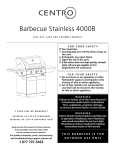
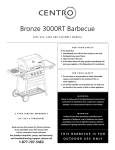
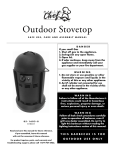
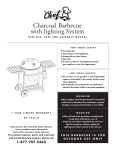
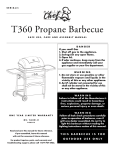

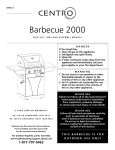
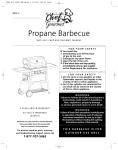
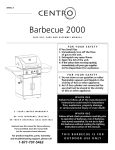

![[MAS 010] G30505 BBQ Manual F](http://vs1.manualzilla.com/store/data/006315885_1-7931826f9e191de9865bd3eb444d7265-150x150.png)
![[MAS 013] G20901 BBQ Manual F](http://vs1.manualzilla.com/store/data/006315834_1-2a7493d2e7dd237965708f5eb02f0454-150x150.png)

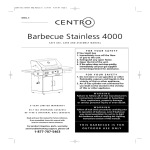
![[WPE 039] E20101 BBQ Manual E 12/22/04 2:05 AM](http://vs1.manualzilla.com/store/data/007299302_1-29c468208e73d97f1377c17012db49e6-150x150.png)
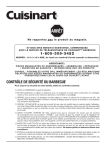
![[CEN 061] 85-1250-6 Manual F](http://vs1.manualzilla.com/store/data/006313003_1-7ea7364065414a96460e03d14822bf45-150x150.png)